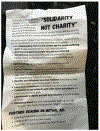Mutual Aid Praxis Aligns Principles and Practice in Grassroots COVID-19 Responses Across the US
- PMID: 38468642
- PMCID: PMC10927022
- DOI: 10.1353/ken.2023.a904080
Mutual Aid Praxis Aligns Principles and Practice in Grassroots COVID-19 Responses Across the US
Abstract
COVID-19 elicited a rapid emergence of new mutual aid networks in the US, but the practices of these networks are understudied. Using qualitative methods, we explored the empirical ethics guiding US-based mutual aid networks' activities, and assessed the alignment between principles and practices as networks mobilized to meet community needs during 2020-21. We conducted in-depth interviews with 15 mutual aid group organizers and supplemented these with secondary source materials on mutual aid activities and participant observation of mutual aid organizing efforts. We analyzed participants' practices in relation to key mutual aid principles as defined in the literature: 1) solidarity not charity; 2) non-hierarchical organizational structures; 3) equity in decision-making; and 4) political engagement. Our data also yielded a fifth principle, "mutuality," essential to networks' approaches but distinct from anarchist conceptions of mutualism. While mutual aid networks were heavily invested in these ethical principles, they struggled to achieve them in practice. These findings underscore the importance of mutual aid praxis as an intersection between ethical principles and practices, and the challenges that contemporary, and often new, mutual aid networks responding to COVID-19 face in developing praxis during a period of prolonged crisis. We develop a theory-of-change model that illuminates both the opportunities and the potential pitfalls of mutual aid work in the context of structural inequities, and shows how communities can achieve justice-oriented mutual aid praxis in current and future crises.
Keywords: COVID-19; applied ethics; community organizing; liberation; mutual aid; praxis; solidarity.
Figures
Similar articles
-
Solidarity, not charity: Learning the lessons of the COVID-19 pandemic to reconceptualise the radicality of mutual aid.Trans Inst Br Geogr. 2022 Jul 1:10.1111/tran.12553. doi: 10.1111/tran.12553. Online ahead of print. Trans Inst Br Geogr. 2022. PMID: 35937505 Free PMC article.
-
Rehearsing post-Covid-19 citizenship: Social representations of UK Covid-19 mutual aid.Br J Soc Psychol. 2022 Oct;61(4):1245-1262. doi: 10.1111/bjso.12535. Epub 2022 Mar 29. Br J Soc Psychol. 2022. PMID: 35349739 Free PMC article.
-
'Anarchist technologies': Anarchism, cybernetics and mutual aid in community responses to the COVID-19 crisis.Organization (Lond). 2023 Jan;30(1):193-209. doi: 10.1177/13505084221090632. Epub 2022 May 2. Organization (Lond). 2023. PMID: 37038431 Free PMC article.
-
[The role of solidarity in a pandemic.].Rev Esp Salud Publica. 2022 Oct 5;96:e202210072. Rev Esp Salud Publica. 2022. PMID: 36196631 Review. Spanish.
-
New and emerging technology for adult social care - the example of home sensors with artificial intelligence (AI) technology.Health Soc Care Deliv Res. 2023 Jun;11(9):1-64. doi: 10.3310/HRYW4281. Health Soc Care Deliv Res. 2023. PMID: 37470136
References
-
- Adereth Maya. 2020. “The United States Has a Long History of Mutual Aid Organizing.” Jacobin, June 14. https://jacobin.com/2020/06/mutual-aid-united-states-unions.
-
- Bonilla Yarimar. 2020. “The Coloniality of Disaster: Race, Empire, and the Temporal Logics of Emergency in Puerto Rico, USA.” Political Geography 78: 102181. 10.1016/j.polgeo.2020.102181. - DOI
-
- Brand Ulrich, and Wissen Markus. 2018. The Limits to Capitalist Nature: Theorizing and Overcoming the Imperial Mode of Living. London: Rowman & Littlefield International Ltd.
MeSH terms
Grants and funding
LinkOut - more resources
Full Text Sources
Medical


